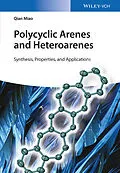The first book of its kind to focus on the chemistry of this promising class of molecules. Edited by an innovator in the field, who has gathered an international team of well-established experts, this is a comprehensive overview of the rapidly developing field of polycyclic (hetero)arenes, specifically highlighting on their molecular design and the latest synthetic procedures, as well as chemical and physical properties. Each chapter is dedicated to a specific compound class, the first eight covering polycyclic arenes, including both planar and non-planar conjugated molecules, while chapters nine to twelve deal with polycylic heteroarenes according to the heteroatoms, namely N, B, S and P. Important current and emergent applications in the field are also discussed, ranging from molecular sensors to electronic devices. The result is an essential reference for researchers in synthetic and physical organic chemistry, supramolecular chemistry, and materials science.
Autorentext
Qian Miao is Associate Professor at the Department of Chemistry at the Chinese University of Hong Kong Shatin. He obtained his B.Sc. degree from the University of Science and Technology of China in 2000 and received his Ph.D. degree from Columbia University, USA, in 2005, under direction of Prof. Colin Nuckolls. He then did postdoctoral research with Prof. Fred Wudl at the University of California, Los Angeles, before he joined the Chinese University of Hong Kong as an assistant professor in 2006. He was promoted to associate professor in 2012. His research aims at the design and synthesis of functional organic materials with high performance and novel functions, and currently focuses on organic semiconductor materials and devices.
Klappentext
Graphene, a giant molecule containing carbon atoms packed in a honeycomb lattice, is an extreme case of the compound class known as polycyclic arenes. Introduction of hetero-atoms, such as B and N, to the _-backbones of polycyclic arenes results in interesting heteroarene molecules that are structurally similar to their hydrocarbon analogues but which show different properties. Polycyclic arenes and heteroarenes play an important role in various fields such as organic electronics, medicine or energy.
The editor, one of the leaders in the field, has gathered an international team of well-established experts, to provide this comprehensive overview of the rapidly developing field of polycyclic (hetero) arenes. Their molecular design and the latest synthetic procedures, as well as chemical and physical properties are specifically highlighted. Each chapter is dedicated to a specific compound class, the first eight covering polycyclic arenes, including both planar and non-planar conjugated molecules, while chapters nine to twelve deal with polycylic heteroarenes according to the heteroatoms, namely N, B, S and P. Important current and emergent applications in the field are also discussed, ranging from molecular sensors to electronic devices. The result is an essential reference for researchers in synthetic and physical organic chemistry, supra-molecular chemistry, and materials science.
Inhalt
Preface XI
List of Contributors XIII
Part I Polycyclic Arenes 1
1 Open-Shell Benzenoid Polycyclic Hydrocarbons 3
Soumyajit Das and JishanWu
1.1 Introduction 3
1.2 Higher Order Acenes 6
1.3 Phenalenyl-Based Diradicaloids 9
1.3.1 Bis(phenalenyl)s 10
1.3.2 Zethrenes 14
1.4 Anthenes and Periacenes 21
1.5 -Extended p-Quinodimethane 27
1.6 Triangulene-Based Triplet Biradicals 31
1.7 Potential Applications 32
1.8 Conclusion 33
References 33
2 Planar Cyclopenta-Fused Polycyclic Arenes 37
Gabriel E. Rudebusch andMichael M. Haley
2.1 Introduction 37
2.2 Acenaphthylenes 37
2.3 Dibenzopentalenes 43
2.4 Indenofluorenes 51
2.5 Conclusions 57
Acknowledgment 58
References 58
3 Growing Buckybowl Chemistry 61
Shuhei Higashibayashi and Hidehiro Sakurai
3.1 Introduction 61
3.2 -Extended Buckybowls 62
3.3 Chiral Buckybowl 65
3.4 Heterobuckybowl 68
3.5 Columnar Crystal Packing of Buckybowls 75
3.6 Summary and Conclusions 80
References 80
4 Polycyclic Arenes Containing Seven-Membered Carbocycles 85
Kwan Yin Cheung and QianMiao
4.1 Introduction 85
4.2 Azulene, Oligo-azulenes, and Fused Azulenes 85
4.3 Polycyclic Arenes Containing 5H-Dibenzo[a,d]cycloheptene Units 92
4.4 Cyclohepta[de]naphthalene, dicyclohepta[de,ij]naphthalene, and Their Benzannulated Derivatives 97
4.5 Curved Polycyclic Arenes Containing Highly Fused Cycloheptatriene 101
4.6 Conclusions 107
Acknowledgment 107
References 107
5 Polycyclic Arenes Containing Eight-Membered Carbocycles 111
Chun-Lin Deng, Xiao-Shui Peng, and Henry N. C.Wong
5.1 Introduction 111
5.2 [8]Annulenes 112
5.2.1 Dehydro[8]annulenes 112
5.2.2 Benzo-Fused [8]annulenes 116
5.2.3 Biphenylene-Fused [8]annulenes 119
5.3 Tetraphenylenes 122
5.3.1 Synthesis 122
5.3.1.1 Ring Opening of the Strained Four-Membered Ring of Biphenylene Derivatives 123
5.3.1.2 Transition-Metal-Mediated Oxidative Coupling 123
5.3.1.3 CycloadditionDeoxygenation Protocol 124
5.3.1.4 Synthesis of Enantiopure Tetraphenylenes 125
5.3.2 Properties and Potential Applications 127
5.4 [8]Circulene 133
5.5 Concluding Remarks 138
References 138
6 Cycloparaphenylenes and Carbon Nanorings 143
Shigeru Yamago, Eiichi Kayahara, and Sigma Hashimoto
6.1 Introduction 143
6.2 Early Developments 144
6.3 Strain and HOMO/LUMO Energies of CPPs 146
6.4 Synthesis of CPPs 147
6.5 Properties of CPPs 154
6.5.1 Photophysical Properties 154
6.5.2 Redox Properties of CPPs 155
6.5.3 HostGuest Chemistry 158
6.6 Summary and Conclusions 160
References 160
7 Advances in Chemistry of Dehydrobenzoannulenes 163
Shunpei Nobusue and Yoshito Tobe
7.1 Introduction 163
7.2 Synthesis and Properties of New DBAs 164
7.2.1 Single-Ring DBAs 164
7.2.2 Multiple-Ring DBAs 166
7.3 DBAs as Graphyne and Graphdiyne Motifs 169
7.3.1 Theoretical and Synthetic Studies on Graphyne and Graphdiyne 170
7.3.2 Synthesis of Graphyne and Graphdiyne Motifs and Related Multiple DBA Systems 171
7.4 DBAs as Supramolecular Building Blocks 171
7.4.1 Crystal Engineering 172
7.4.2 3D Assemblies: Gels, Fibers, Vesicles, and Liquid Crystals 174
7.4.3 2D Self-Assembly on Surfaces and Interfaces 175
7.5 DBAs in Optoelectronic Applications 180
